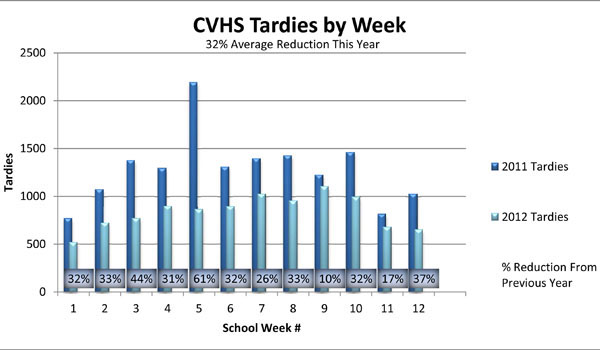New tardy sweeps cause a decrease of late students
Administrators have credited the recent increase in tardy sweeps to drastically declining the number of late students this year. According to new statistics, tardies for the 2012 school year have decreased an average of 32 percent during the first twelve weeks of school, compared to the past 2011 school year.
The new regulations were set into place this year after administration discovered there were over 40,000 tardies the previous school year. The new rules state that there will be a maximum of three tardy sweeps every week for the 2012-2013 school year.
According to attendance and detention supervisor Darrin Vanderpan, the results of the recent tardy sweeps has been overwhelmingly positive, for teachers and students.
“With more students in class, the students are able to learn more, the teachers are able to teach more, and even the students that aren’t getting there late aren’t disrupted by the people who are late,” said Vanderpan.
Many teachers have also taken notice and supported the increased tardy sweeps.
“I think they (tardy sweeps) are good,” said English teacher Tina Johansson. “Although I haven’t seen a huge difference in my classroom, I’ve definitely heard from many other teachers and administrators the overwhelmingly positive effects.”
The new information shows the differences in both students caught in tardy sweeps and calls home between 2011 and 2012. There was a 31 percent decrease in tardies in week one, a 33 percent decrease in week two, a 44 percent decrease in week three, a 31 percent decrease in week four, an astounding 61 percent decrease in week five, a 32 percent decrease in week six, a 26 percent decrease in week seven, a 33 percent decrease in week eight, a ten percent decrease in week nine, a 32 percent decrease in week ten, a 17 percent decrease in week 11, and a 37 percent decrease in week 12.
And attendance isn’t the only thing tardy sweeps are helping. They are also improving students’ grades.
“We had a huge number of D’s, F’s, and ‘incompletes’ in the classes,” says Vanderpan.
“One of the things we noticed with the D’s F’s and I’s was that almost all had attendance issues, either tardies or cuts.”
According to Vanderpan, the new regulations were set in hopes to not only get students on time but also to keep students in class, and ultimately work to help them learn and boost their grades. The results speak for themselves; there has been an approximate eight percent decrease in D, F, and incomplete grades during last quarter’s progress reports.
“The data is showing that tardy sweeps have been successful in helping the students get better grades, which is really what our goal was to begin with,” said Vanderpan.
Tardy sweeps are set to continue, but Vanderpan says change all depends on student’s behavior.
“It (tardy sweeps) really depends on the students ability to self- regulate,” he said. “If they’re responsible, then we won’t need this many.”

